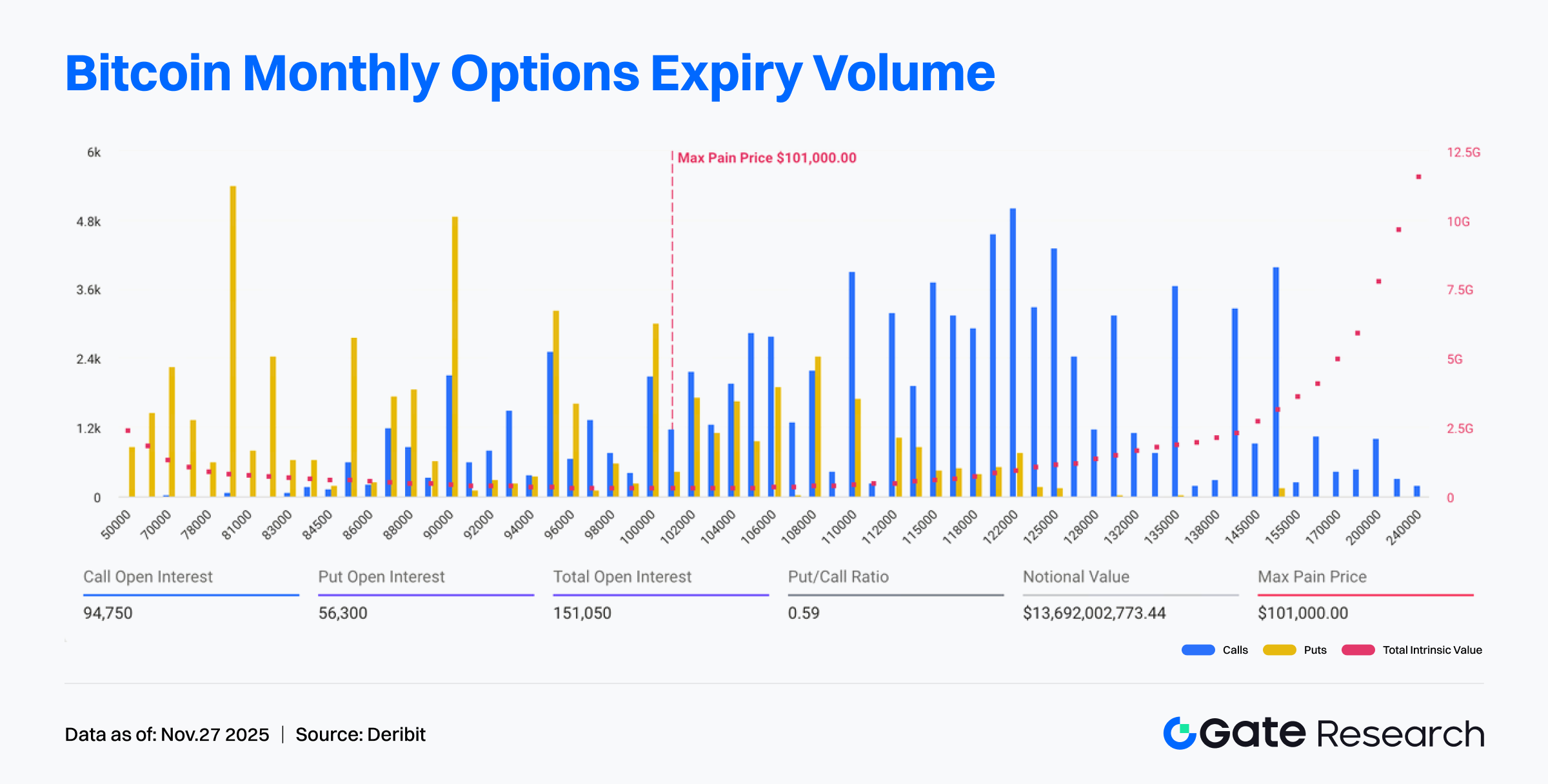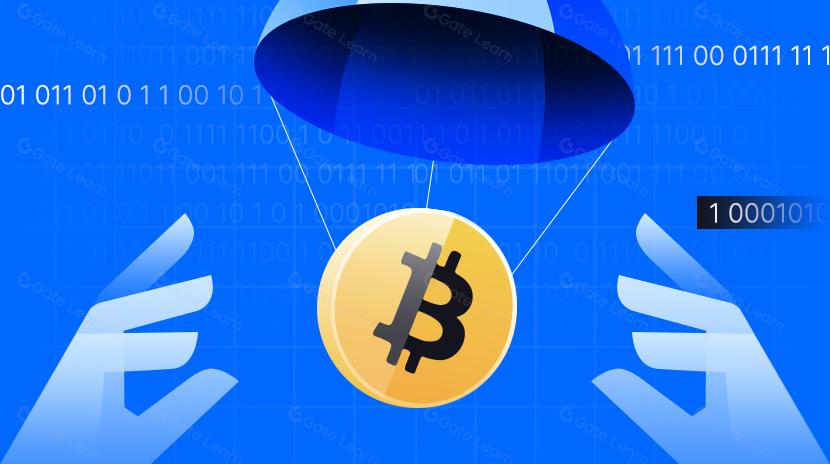Gate Research: Plasma Token Down 90% From Early Peak | Bitcoin Faces $13.6B in Monthly Options Expiry
Summary
- BTC and ETH have respectively reclaimed the key psychological levels of $90,000 and $3,000, with market sentiment showing clear signs of recovery and capital rotation evident across multiple sectors, including platform tokens, public chains, and memecoins.
- S&P downgrades USDT’s stability rating to “Weak”; the Cosmos community initiates research on a new tokenomics model for ATOM; Ethereum co-founder Vitalik donates to privacy messaging applications.
- The Plasma token has declined by 90% from its early peak, with the project far from realizing its ambitious vision, emerging as one of the most representative cases of a failed new token listing in recent times.
- Benefiting from investor enthusiasm driving sustained strength in AI-related stocks, while the crypto market—fueled by excessive leverage—has seen Bitcoin drop over 20% in the past month.
- Bitcoin faces a $13.6 billion monthly options expiration this Friday, with out-of-the-money contracts comprising 77%, potentially amplifying short-term volatility through hedging activities.
- HYPE, SUI, and EIGEN are scheduled for token unlocks in the next 7 days, valued at approximately $359 million, $68.51 million, and $22.62 million, respectively.
Market Overview
Market Commentary
- BTC Market Update — On the morning of the 27th, BTC staged a strong volume-driven breakout from the consolidation range of $87,000–$88,000, swiftly rallying above $90,000, with intraday gains exceeding 3%. From a technical perspective, the MA5 has hooked upward and crossed above both the MA10 and MA30, followed by the MA10’s subsequent ascent, forming a classic short-cycle bullish alignment across the three lines; the MA30 has also begun a gradual rise, further confirming the strengthening trend. Currently, the three moving averages display a bullish divergence structure, with the $88,000 level near the MA30 serving as key short- to medium-term support—a breach below which could signal the end of the short-term uptrend. Overall, as market sentiment continues to recover, BTC is poised to challenge levels above $92,000.
- ETH Market Update — On the morning of the 27th, ETH surged in tandem with BTC, breaking through the $3,000 psychological level and peaking at $3,050, with intraday gains exceeding 3%. Technically, the MA5, MA10, and MA30 are aligned in a bullish configuration, with the MA30 (around $2,960) providing critical medium-term support to fuel steady upward momentum. In general, ETH’s price action remains highly correlated with BTC; should BTC hold firm above $90,000, ETH is likely to target the $3,100–$3,150 range. Conversely, a BTC pullback could see ETH retest support at the $3,000 mark, with a break below $2,960 potentially shifting the short-term trend toward consolidation with a bearish bias.
- Altcoins — Market sentiment has shown significant recovery, with capital reactivating under the leadership of BTC and ETH, as the rally diffuses from major coins into platform tokens, public chains, and meme sectors—clear signs of resurgent risk appetite.
- Stablecoins — The total stablecoin market capitalization currently stands at $305.35 billion, reflecting a weekly increase of $2.131 billion and nearly recouping last week’s decline.
- Gas Fees — Over the past week, Ethereum network gas fees have generally remained below 1 Gwei, with the highest single-hour peak at 6.96 Gwei; as of November 27, the daily average gas fee is 0.065 Gwei.
Trending Tokens
Over the past 24 hours, the cryptocurrency market has exhibited overall strength. BTC and ETH have respectively reclaimed the $90,000 and $3,000 psychological levels, fostering a broader sentiment recovery and propelling platform tokens like GT to surge upward. Hotspot token sectors have delivered standout performances, with Merlin (MERL) exploding over 150% amid its mainnet upgrade and short-squeeze dynamics; XION (+98.6%) showing robust activity driven by its KRW trading pair; and BANANAS31 (+66.6%) seeing trading volume skyrocket to $470 million, signaling a resurgence in meme coin fervor. The following sections will analyze the drivers behind each token’s rally in detail.
MERL Merlin(+157.97%,Market Cap: $550m)
According to Gate.com market data, the MERL token is currently quoted at $0.0552, with an increase of over 150% in the past 24 hours. Merlin Chain is a Bitcoin-native Layer 2 scaling solution developed by Bitmap Technology and launched in January 2024. Data from DeFiLlama shows that Merlin’s TVL exceeds $44 million, with a 7.8% growth in the past 24 hours.
The surge in MERL is driven by the combined resonance of narrative momentum and funding conditions. Recently, Merlin Chain completed a 12-hour mainnet upgrade aimed at improving scalability and optimizing ZooKeeper performance for coordinating distributed systems, which will further reduce latency and support the deployment of more dApps; this has been widely regarded by the community as a short-term price catalyst. In addition, the annualized negative funding rates of MERL USDT-margined perpetual contracts on major exchanges have all exceeded 2,000%, resulting in sustained upward price pressure in the short term due to short squeezing.
XION XION(+98.6%,Market Cap: $30.25m)
According to Gate.com market data, the XION token is currently quoted at $0.067, with a 24-hour gain of 100%. XION is a Layer 1 blockchain developed by the Burnt team, built on the Cosmos SDK and utilizing the Tendermint Proof-of-Stake (PoS) consensus mechanism. It focuses on “chain abstraction” and consumer-grade Web3 experiences, aiming to render blockchains “invisible”—eliminating the need for wallets, seed phrases, or gas fees, while enabling logins via Face ID or credit cards and supporting USDC as the gas token.
The surge in XION is inextricably linked to momentum from Korean investors. Following its recent listing on a major Korean domestic exchange with a KRW trading pair, Korean whales have piled into the hype surrounding XION, with the XION/KRW pair accounting for over 30% of its spot trading volume. However, it is worth noting that strategic backer and team allocations of XION tokens are set to begin phased unlocks starting in December, potentially introducing tens of millions of dollars in selling pressure into market circulation over the coming months.
BANANAS31 Banana For Scale(+66.62%,Market Cap: $58.7m)
According to Gate.com market data, the BANANAS31 token is currently quoted at $0.0058, with an increase exceeding 60% in the past 24 hours. BANANAS31 is a memecoin built on the Binance Smart Chain (BSC), named and branded after the popular internet meme “Banana for Scale” (where people use a banana as a humorous reference object for scale in photographs). The project aims to integrate “internet culture’s sense of humor with blockchain, AI, dApps, and token economics.”
This wave of gains in BANANAS31 is not a “silent pump” but is accompanied by active trading volume alongside surges in community engagement and capital inflows. Gate.com market data indicates that BANANAS31’s 24-hour trading volume has reached as high as $475 million. Moreover, with the recent resurgence in meme activity on BSC, such memecoins that have undergone deep accumulation phases and feature relatively strong meme culture tend to attract greater favor from speculators.
Key Market Data Highlights
S&P Global Ratings Downgrades Tether USDT Rating to “Weak”
In a report published in November 2025, S&P Global Ratings downgraded the stablecoin stability rating for Tether’s USDT from its previous level of “4 (constrained)” to “5 (weak),” the lowest grade in the agency’s rating framework. The primary reasons for the downgrade include a rising proportion of “high-risk assets” within USDT’s reserve portfolio (such as BTC, precious metals, corporate bonds, and secured loans); concurrently, S&P identified structural deficiencies in Tether’s information disclosure, asset segregation, hedging mechanisms, and counterparty risk management for hedges. The report specifically highlighted that, as of the most recent review, high-risk assets backing USDT accounted for approximately 24% of its reserves, a marked increase from about 17% a year earlier; correspondingly, the allocation to the most ideal and secure assets for supporting stablecoin stability—such as Treasuries or short-term Treasury bills—has declined.
This downgrade by S&P is not an arbitrary attempt to pressure USDT, nor does it necessarily indicate an actual problem with the stablecoin; rather, it aligns with the agency’s broader trend in recent years of reassessing risks, transparency, asset structures, and redemption security within the stablecoin industry. Amid heightened volatility in the crypto asset markets and growing scrutiny from traditional financial institutions toward stablecoin participants, the asset structure stability and transparency of stablecoins—as alternatives to or bridges for digital dollars—have become pivotal determinants of their credibility. USDT’s increasing allocation of reserves to BTC is viewed by traditional industry standards as exposure to a high-risk, high-volatility asset, which contravenes the conventional notion of a dollar substitute or monetary equivalent. In response, Tether’s CEO issued a high-profile rebuttal, proudly declaring it an honor “to be loathed by the old system.”
ATOM’s Long-Term Underperformance Prompts Cosmos Community Proposal for Tokenomics Overhaul
Cosmos is an ecosystem/network characterized by “blockchain interoperability,” “modular chains + custom chains + cross-chain communication.” It enables seamless interaction among different blockchains through the Cosmos SDK and the Inter-Blockchain Communication (IBC) protocol. However, in recent years, both the adoption rates within the Cosmos ecosystem and the market price of ATOM have fallen short of expectations. In response, the Cosmos community is actively researching and soliciting feedback to prepare for a comprehensive overhaul of ATOM’s economic model.
The research on the new economic model aims to design a tokenomics framework grounded in fee revenue, rather than relying solely on inflation and staking. In essence, this would tie ATOM’s value more closely to the genuine economic activities and income generated within the Cosmos ecosystem itself (such as on-chain usage, dApp fees, IBC cross-chain transactions, and infrastructure utilization). This initiative primarily seeks to address the longstanding issues faced by the ATOM token under its existing tokenomics:
- Mitigating inflation and selling pressure: The previous issuance and inflation mechanisms, tied to staking and reward structures, could result in excessive token releases combined with holder sell-offs, thereby eroding long-term value.
- Enhancing ATOM’s value capture as a foundational or network asset: As the Cosmos ecosystem generates more fees, holders of ATOM—as the native token—should be positioned to share in that value accrual.
Furthermore, ATOM proponents hope that this overhaul—conducted through a public, transparent, and community-driven process involving research and voting—will help restore and strengthen community trust in Cosmos.
Vitalik Donates to Privacy Messaging Apps Session and SimpleX Chat, Reaffirming the Importance of Privacy Protection
Ethereum co-founder Vitalik Buterin announced on social media a donation of 128 ETH each to Session and SimpleX Chat, aimed at supporting their development and advancement in areas such as “privacy-focused messaging + decentralization + metadata protection + permissionless user account creation.” Vitalik emphasized that these two projects are committed to “end-to-end encryption + privacy + decentralization + protection of metadata (such as sender/recipient, timing, and frequency) + multi-device support + resistance to Sybil/DoS attacks,” which he views as critically important for the future of user privacy and encrypted communications ecosystems.
Session is a decentralized chat application developed by the Australian team at Loki Foundation (now rebranded as Session Network), operating on a blockchain network. Users can register without a phone number, and messages are relayed through anonymous nodes, rendering metadata virtually untraceable. SimpleX Chat, by contrast, adopts a different approach: it relies on no fixed servers or user IDs, instead leveraging end-to-end ephemeral (temporary) connections to enable truly centerless communication. Both projects are actively addressing the persistent issue of metadata leakage in traditional encrypted chat software—namely, the potential for analysis and inference of who is communicating with whom, when, and with what frequency.
That said, decentralized communication still lags behind traditional social applications in terms of user experience, performance, and scalability. Striking a balance between privacy and convenience remains the foremost technical challenge ahead. Regardless of the outcomes, Vitalik’s donation sends a clear signal: amid the market’s clamor, there are still voices in the crypto world upholding the original ideals—a truly free, uncensored internet that safeguards privacy.
Focus of the Week
Plasma Token Down 90% from Early Peak, Project Far from Delivering on Its Grand Vision
Plasma once garnered immense attention for its bold claim to revolutionize stablecoin infrastructure. The project launched its native token XPL, which quickly attracted over $500 million in funding shortly after going live, with the token price surging to a high of $1.67 and market capitalization exceeding $2 billion. It promised “next-generation blockchain” features such as high throughput, instant payments, and seamless scalability, appearing to possess all the potential to disrupt the stablecoin sector.
However, in terms of actual on-chain usage and market performance post-launch, the project has fallen far short of realizing its ambitious vision. As hype has dissipated and usage volumes have severely underperformed expectations, XPL’s price has plummeted rapidly, now trading in the $0.18–$0.20 range—a retracement of approximately 88–90% from its peak. Although the project team released an engineering progress update in November, it failed to deliver meaningful catalysts or restore community confidence. This has emerged as one of the most emblematic cases of a failed new token launch in the recent crypto market landscape, underscoring the common risks inherent in so-called “stablecoin infrastructure + high-growth narratives” when lacking substantive on-chain data and transparent communication. For investors, this episode serves as a stark reminder: even for “infrastructure-type” projects in the future, one must remain vigilant by monitoring genuine usage metrics and liquidity before conducting a prudent assessment of potential value and risks.
Bitcoin Down Over 20% in the Past Month: Why It’s Underperforming the Stock Market
Despite ongoing bullish catalysts for Bitcoin, its recent performance has markedly lagged behind the stock market. The cryptocurrency has declined more than 30% from its highs, breaking below the 50-week moving average, while altcoins have suffered even steeper drops—many exceeding 50%. Over the past month alone, Bitcoin has fallen 22%, a stark contrast to traditional markets. During the same period, the S&P 500 dipped just 2.5%, and the Nasdaq—historically aligned with Bitcoin’s movements—shed only 4%.
This divergence stems from the fact that equity markets, exemplified by the S&P 500 and Nasdaq-100, have continued to thrive on investor enthusiasm for AI, driving sustained gains amid robust corporate earnings and delayed expectations for Federal Reserve rate cuts. In contrast, the crypto market has been hampered by excessive leverage, with prior liquidation cascades and persistent selling pressure on risk assets fostering a cautious overall sentiment. Compounding this are institutional profit-taking and macroeconomic uncertainties, including trade tensions and inflationary pressures, which have weighed heavily on Bitcoin and major crypto assets, exerting pressure on both technical indicators and funding flows. Many long-term holders have capitalized on highs to realize gains, further softening market liquidity and sentiment.
Looking ahead, most market analysts anticipate that catalysts such as regulatory clarity and declining interest rates will underpin a Bitcoin rebound in 2026.
Bitcoin Faces $13.6 Billion Monthly Options Expiration: Hedging Likely to Amplify Volatility
Following a sharp retracement, Bitcoin is approaching Friday’s monthly options expiration. During this week’s pullback, the price plunged over 30% to $81,000 before rebounding to around $90,000; however, overall sentiment remains cautious amid increasingly defensive positioning. Against this backdrop, the market is paying particularly close attention to the scale of this expiration. Deribit data indicates that the total expiring contracts amount to 151,050 BTC, comprising 94,750 BTC in call options and 56,300 BTC in put options, with a total notional value of approximately $13.6 billion. The put/call ratio stands at 0.59, signaling that bullish positions still dominate but with a notable uptick in demand for downside protection.
The maximum pain point is at $101,000—about 12% above the spot price—highlighting how the current price has deviated significantly from the optimal range for option sellers. Currently, around $3.3 billion in contracts are in-the-money (accounting for roughly 22%), while the remaining $11.7 billion remain out-of-the-money (about 77%), indicating that traders have allocated substantial positions in anticipation of a breakout from the prevailing consolidation range. Put options are most concentrated near the $81,000 strike price, while call options are primarily clustered above $120,000; however, given the spot price’s distance, most of these high-side calls fall outside the exercise range. Overall, market sentiment remains fragile, with a heavy weighting toward out-of-the-money positions shaping the funding structure. Near key strike prices, market makers’ hedging activities are likely to further magnify short-term volatility, keeping Bitcoin’s price swings elevated ahead of Friday’s expiration.

Funding Weekly Recap
According to data from RootData, between November 21 and November 27, 2025, a total of 12 crypto and related projects announced the completion of financing or mergers and acquisitions, spanning multiple sectors including fintech, DApps, MPC wallets, RWA, DEX, and beyond. Below is a brief introduction to the top-ranked projects by funding scale this week:
Dunamu
On November 26, Naver Financial announced the acquisition of Dunamu via a stock-swap transaction, valuing the company at approximately $10.3 billion.
Dunamu is a leading South Korean fintech company specializing in blockchain and financial technology, operating the country’s largest cryptocurrency exchange, Upbit. Korean internet giant Kakao currently holds a 10.88% stake in Dunamu, down from approximately 20% previously held through its affiliated funds.
Monad
On November 22, Monad announced the completion of a $188 million funding round through a public sale executed on the Coinbase platform.
Monad is developing a high-performance Layer 1 blockchain designed for next-generation decentralized applications. Its mission is to accelerate the disruptive potential of decentralization by building a blockchain that is 100 to 1,000 times faster than its closest competitors. This performance leap aims to eliminate severe bottlenecks in existing blockchains and enable more complex applications with broader real-world adoption.
Baanx
On November 24, Baanx announced the successful closing of a $175 million funding round led by Exodus.
Baanx is a 100% B2B2C-focused service provider offering API-driven digital and crypto-friendly financial services, including debit cards (physical and virtual), digital wallets, IBAN accounts, crypto remittances, forex/remittance solutions, and payment gateways. Through its partnership with CL Technology, Baanx also delivers white-label, fully hosted applications, enabling global brands to seamlessly integrate blockchain technology, digital assets, and cryptocurrency at scale.
Next Week to Watch
Token Unlocks
According to data from Tokenomist, the market is set to experience significant token unlocks over the next 7 days (November 28–December 4, 2025). The top three unlocks are outlined below:
- HYPE is scheduled to unlock tokens valued at approximately $359 million in the coming 7 days, representing 3.7% of its circulating supply.
- SUI will unlock tokens worth about $68.51 million over the next 7 days, accounting for 1.2% of its circulating supply.
- EIGEN is poised to unlock tokens valued at roughly $22.62 million in the next 7 days, equivalent to 8.3% of its circulating supply.
References:
- Gate, https://www.gate.com/trade/BTC_USDT
- Farside Investors, https://farside.co.uk/btc/
- Gate, https://www.gate.com/trade/ETH_USDT
- Gate, https://www.gate.com/crypto-market-data
- Coingecoko, https://www.coingecko.com/en/cryptocurrency-heatmap
- Rootdata, https://www.rootdata.com/Fundraising
- Tokenomist, https://tokenomist.ai/
- CoinDesk, https://www.coindesk.com/markets/2025/11/20/why-bitcoin-is-underperforming-equities-despite-bullish-catalysts
- CoinDesk, https://www.coindesk.com/markets/2025/11/26/a-new-crypto-project-vowed-to-transform-stablecoins-then-its-token-crashed-90
- CoinDesk, https://www.coindesk.com/markets/2025/11/25/bitcoin-faces-usd13-3b-monthly-options-expiry-as-btc-trades-well-below-max-pain
- DeFiLlama, https://defillama.com/chain/merlin
- Reuters, https://www.reuters.com/business/finance/tethers-stablecoin-downgraded-weak-sp-assessment-2025-11-26/?utm_source=chatgpt.com
- Cosmos Hub Forum, https://forum.cosmos.network/t/atom-tokenomics-research-kickoff/16462?u=mag
Gate Research is a comprehensive blockchain and cryptocurrency research platform that provides deep content for readers, including technical analysis, market insights, industry research, trend forecasting, and macroeconomic policy analysis.
Disclaimer
Investing in cryptocurrency markets involves high risk. Users are advised to conduct their own research and fully understand the nature of the assets and products before making any investment decisions. Gate is not responsible for any losses or damages arising from such decisions.
Related Articles

Exploring 8 Major DEX Aggregators: Engines Driving Efficiency and Liquidity in the Crypto Market

What Is Copy Trading And How To Use It?

How to Do Your Own Research (DYOR)?

What Is Technical Analysis?

12 Best Sites to Hunt Crypto Airdrops in 2025
